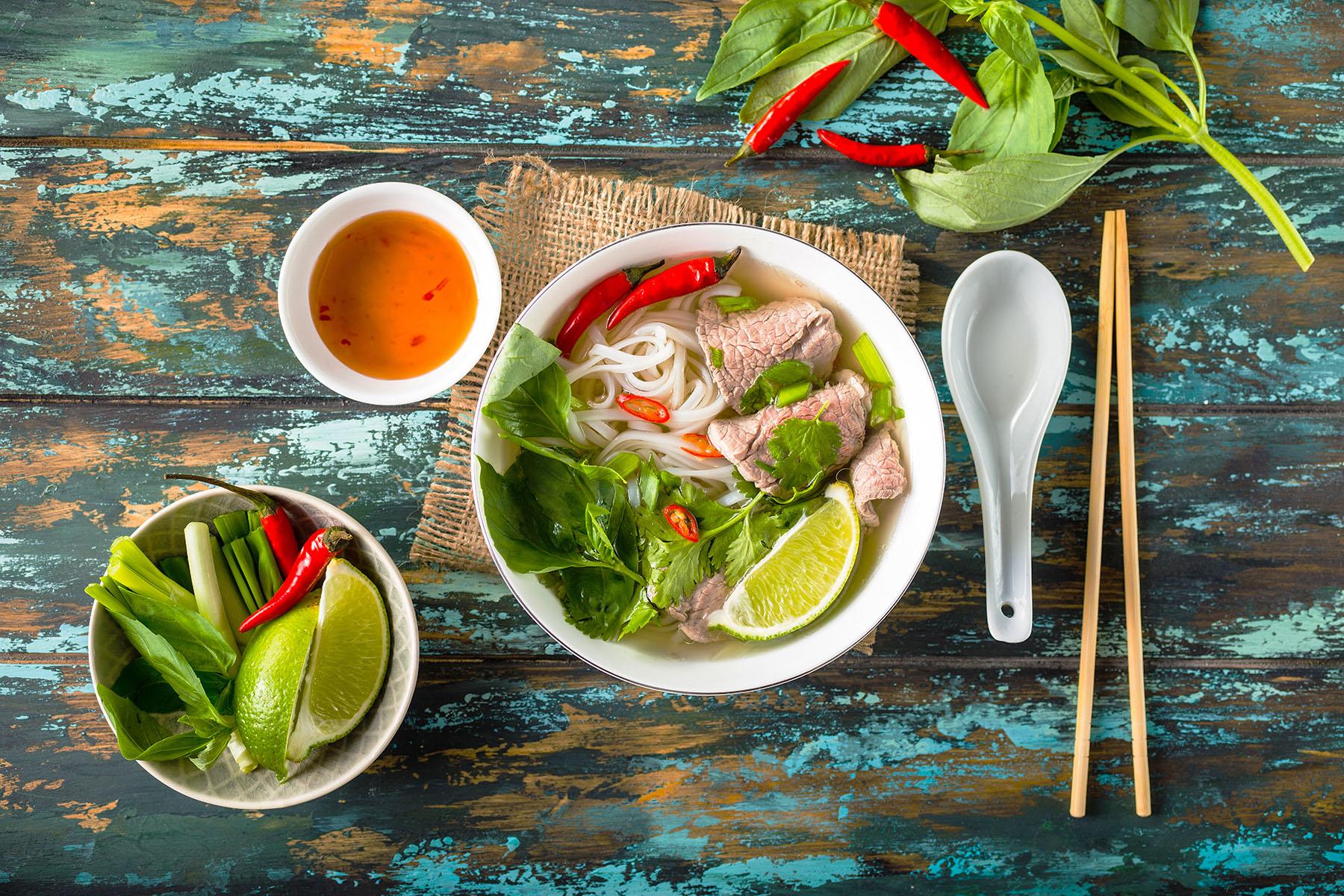From pho in Vietnam to acai in Brazil, these are the most common foods that are hard for international travelers to pronounce—and how to say them correctly.
Instead of avoiding particularly daunting items on the menu that are a real struggle to say, do your best to learn how to pronounce them correctly. Ask locals to say the name of a dish that’s hard to pronounce then take a voice recording of the way they say it or write down how it sounds phonetically.
Pho
WHERE: Vietnam
Pho is a savory wet noodle dish from Vietnam that’s loaded with flavor and usually eaten for breakfast. Pho is actually the name of the long flat rice noodles used in the soup.
The proper pronunciation is “fuh” with the “uh” sound dragged out.
INSIDER TIPTear up all of the herbs that are served as a garnish with the noodle dish before you add them in.
Sisig
WHERE: The Philippines
Sisig is a hearty Filipino dish that’s made up of meat from a pig’s liver, face, ears, cheeks, and snout that’s been boiled, grilled, and fried to a crisp. The meat is seasoned with vinegar and onions and served with an egg on top and garlic rice.
The proper pronunciation is “see-sig.”
Recommended Fodor’s Video
Tempeh
WHERE: Indonesia
Tempeh is a common staple among Indonesian diets and a meat alternative. It’s a plant-based protein made from whole fermented soybeans that are usually served fried with Gado-Gado. It’s savory, has a nutty taste, and is seen at vegan eateries around the globe.
The proper pronunciation is “tem-pey.”
Bibimbap
WHERE: South Korea
This ultra-healthy Korean dish is everything-but-the-kitchen-sink with a bed of rice topped with an assortment of things from sautéed vegetables, beef, and eggs topped with herbs and seeds.
The proper pronunciation is “bee-beem-bahp.”
INSIDER TIPMake your bibimbap extra tasty by adding pickled daikon or shredded seaweed.
Matcha
WHERE: Japan
Matcha is a specialty shade-grown green tea that’s been ground into a fine powder. It’s traditionally consumed as a tea but has become a trendy dessert staple in everything from ice cream to cookies.
The proper pronunciation is “mah-tchah.”
INSIDER TIPMatcha is a superfood that’s high in antioxidants.
Mofongo
WHERE: Puerto Rico
Mofongo is a drool-worthy dish from Puerto Rico of mashed and fried green plantains that are often stuffed with an assortment of fillings such as chicharrón (crispily fried pork rinds). This dish may be hard to say, but you won’t regret ordering it.
The proper pronunciation is “mo-fon-go.”
Poke
WHERE: Hawaii
Poke is a native Hawaiian dish that typically consists of a bowl of rice that’s topped with diced raw fish. The traditional staple was brought to life by fishermen who needed a hearty snack and is now an Instagram darling with many colorful and healthy renditions.
The proper pronunciation is “po-kay.”
Poutine
WHERE: Canada
Poutine comes from Quebec, the French region of Canada, which helps explain why we’ve all been saying the name of this food wrong. Poutine doesn’t rhyme with clementine. You’ll want to order this correctly as a butchered pronunciation is keeping you away from cheesy french fries.
The proper pronunciation is “poo-tin.”
Jicama
WHERE: Mexico
Jicama is a fiber-rich root vegetable found in Mexico. It’s packed with nutrients and is usually chopped up raw and tossed into salads or slaws. Jicama is crunchy, refreshing, and slightly sweet—somewhat similar to a turnip. It’s believed to encourage weight loss, so, dig in!
The proper pronunciation is “hee-kah-mah.”
Mole Poblano
WHERE: Mexico
Mole Poblano is a fantastic thick sauce that combines two unlikely ingredients–chocolate and chili. Mole actually translates to “mix,” not to “burrowing naked mole rat.” Some people do eat those.
The proper pronunciation is “moh-lay.”
INSIDER TIPTaste authentic mole dishes in Oaxaca or Puebla, Mexico.
Quinoa
WHERE: Bolivia
Quinoa is a popular superfood that’s often referred to as a grain. It’s actually not a grain but a chenopod, not unlike spinach. The gluten-free starch is high in protein and comes from Latin America and can be traced back to the Quechua people.
The proper pronunciation is “keen-wah.”
Ceviche
WHERE: Peru
Ceviche is a refreshing and healthy dish from Peru that calls for diced raw fish served wet with an array of herbs and lime juice that’s often consumed with either corn tortilla or plantain chips in lieu of a fork. The “v” is pronounced like a “b.”
The proper pronunciation is “seh-bee-chay.”
Acai
WHERE: Brazil
This Brazilian superfood is really difficult for some people to say correctly. Remember to use a soft “s” sound instead of a hard “c” sound. Acai is a berry that’s often used in juices and smoothies. It’s jam-packed with antioxidants, high levels of Vitamin A, calcium, iron, fiber, and it’s extremely tasty.
The proper pronunciation is “ah-sigh-ee.”
Bruschetta
WHERE: Italy
Bruschetta is quite possibly the most commonly butchered food word from Italy. The ‘sch’ is not a ‘sh’ sound but a ‘sk’ sound. Bruschetta means toasted, so the name doesn’t describe the toppings—which can be anything from tomatoes and garlic to sliced meat—but the bread itself.
The proper pronunciation is “bru-sket-ta.”
Gnocchi
WHERE: Italy
Gnocchi is a divine Italian pasta dish that’s made up of tiny potato dumplings. You could refer to gnocchi as knots, as the name of the pasta comes from the Italian word “nocchio” which means a knot in the wood.
The proper pronunciation is “nyaw-kee.”
INSIDER TIPGnocchi are also important in Uruguay where they have a monthly holiday to honor the dish on the 29th.
Quark
WHERE: Germany
Quark is the kind of silky smooth cream cheese that you want to spread on everything—it’s also loaded with protein. But, you’ve probably never ordered it as it’s a real tongue twister.
The proper pronunciation is “kwark.”
INSIDER TIPQuark is also a popular cheese in some Scandinavian countries.
Paella
WHERE: Spain
Paella is a hearty rice dish from the Spanish coastal city of Valencia. It’s usually prepared in a massive pan that serves up portions that could quite literally feed a village. Paella calls for rice, rabbit meat, chicken, seafood, vegetables, and a bit of saffron.
The proper pronunciation is “pie-aye-ya.”
Horchata
WHERE: Spain
Spain gives us many of the best foods on earth but their simple sweet drink may be one of the most delicious and downright impossible to say. Horchata is a thick drink that is nutty and a bit spicy as it’s made from jicaro seeds and cinnamon.
The proper pronunciation is “orr-cha-ta.”
Macaron
WHERE: France
Macarons are tiny round, pastel-colored, picturesque French meringue-based sugary sweet cookies. They are not equally-delicious coconut macaroons—another sweet treat that’s also from France. French bakeries pride themselves in the delicate work that goes into making a beautiful macaron, sometimes they’re even coated in real gold leaf flakes.
The proper pronunciation is “mah-kuh-rohn.“
Foie Gras
WHERE: France
If eating the liver of a duck that’s been forcibly fattened up is your kind of thing, you should at least be able to order the dish properly.
The proper pronunciation is “fwah grah.”
INSIDER TIP Foie Gras is considered a luxury food by many but is also often considered animal cruelty as the ducks are force-fed.
Tzatziki
WHERE: Greece
Tzatziki is a condiment from Greece that’s made from plain sour yogurt (that’s been salted and strained), cucumbers, garlic, olive oil, and dill. The delicious dip is served with most Greek meat dishes and sandwiches but is good on just about everything.
The proper pronunciation is “dzah-dzee-kee.”
INSIDER TIPTzatziki can be traced back to the Ottoman Empire and is sometimes called “cacık” or “tarator.”
Gyro
WHERE: Greece
Gyro is a Greek street food. The sandwich is made from soft pita bread that’s stuffed with shredded rotisserie meat, often pork, chicken, lamb or beef, and toppings such as onions, tomatoes, and tzatziki.
The proper pronunciation is “yee-roh” with a rolling “r” sound.
Worcestershire
WHERE: England
Although this is an English word it’s often mispronounced by native English speakers. It doesn’t rhyme with “hire.” The fermented sauce is often used in Bloody Mary’s. The original version calls for anchovies so it isn’t vegan-friendly.
The proper pronunciation is “wuss-ta-shure,” but most Brits to just shorten it to “wuu-sta” sauce.
Scone
WHERE: Scotland
“Scone” can be traced back to modern-day Scotland but some believe it comes from the Dutch word schoonbrot which translates to “beautiful bread.” No matter where it came from, one thing is for sure: it’s pronounced more like “gone” than it is “cone.”
The proper pronunciation is “sk-on.”
Are you pronouncing these correctly? Is there a food you think you always say incorrectly? Any others you think should be on the list? We want to know!




